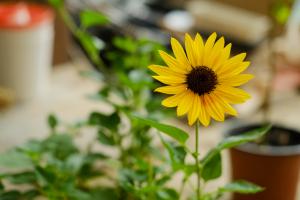What to Put at the Bottom of a Planter Pot
Choosing the right planter pot for your plants is just as important as choosing the right soil or fertilizer for them. However, when it comes to deciding what to put at the bottom of a planter pot, many people are clueless. In this article, we will explore some of the options available and their benefits.
1. Drainage Material
The most common material used at the bottom of planter pots is drainage material. This can be in the form of rocks, gravel, or broken pottery. The reason for adding drainage material is to allow excess water to flow out of the pot instead of sitting at the bottom and causing root rot. It also helps to prevent soil from washing out of the pot when you water your plants.
When using drainage material, make sure to add a layer that is at least one to two inches thick. This will provide enough space for excess water to collect without causing any harm to your plants.
2. Landscape Fabric
If you are concerned about the drainage material interfering with the soil or the drainage holes, you can add a layer of landscape fabric on top of it. This will allow water to flow through but prevent soil from escaping. It also helps to prevent weed growth in the pot.
When using landscape fabric, make sure to trim it to fit the size of your pot. You can also use a staple gun to secure it in place, or simply tuck the excess fabric under the drainage material.
3. Coffee Filters
If you don't have drainage material or landscape fabric on hand, you can use coffee filters instead. Simply place a few at the bottom of the pot before adding soil. The coffee filters will allow water to flow through but prevent soil from escaping.
However, this method is not suitable for plants that require a lot of water, as the coffee filters can become clogged and prevent adequate drainage.
4. Sand
If you are planting succulents or cacti that require well-draining soil, you can use sand at the bottom of the pot. Sand allows water to flow through quickly, preventing water from accumulating at the bottom.
When using sand, make sure to add a layer that is at least one to two inches thick. You can also mix sand with other materials, such as rocks, to provide better drainage.
Conclusion
Choosing what to put at the bottom of a planter pot is essential for the health of your plants. Whether you choose drainage material, landscape fabric, coffee filters, or sand, make sure to provide adequate drainage for your plants to thrive.
Remember to also choose a pot that is the right size for your plant, as well as the right amount of sunlight, water, and nutrients for its specific needs.

 how many times do yo...
how many times do yo... how many planted tre...
how many planted tre... how many pine trees ...
how many pine trees ... how many pecan trees...
how many pecan trees... how many plants comp...
how many plants comp... how many plants can ...
how many plants can ... how many plants and ...
how many plants and ... how many pepper plan...
how many pepper plan...































